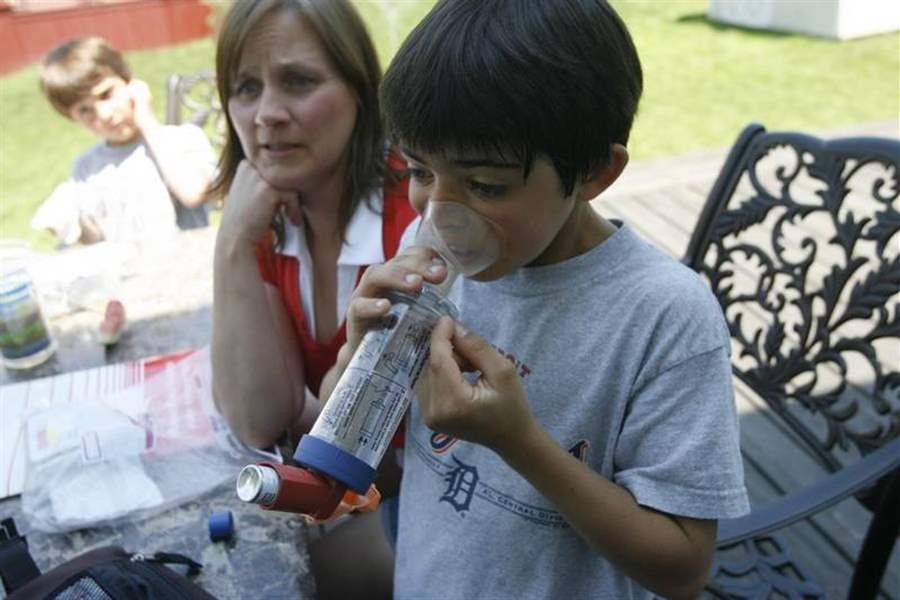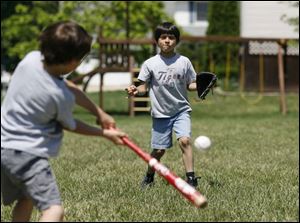
Childhood asthma signs dangerously deceptive
6/17/2007
Carl Antrassian demonstrates what he must do to use his inhaler as his mom, Johanna, center, and brother Neil watch. Carl and his entire family are well-acquainted with his regimen of medication.

Carl Antrassian demonstrates what he must do to use his inhaler as his mom, Johanna, center, and brother Neil watch. Carl and his entire family are well-acquainted with his regimen of medication.
Johanna Antrassian was sure her severely asthmatic son was doing well enough last year to talk to his doctor about cutting back on some of his daily medications.
Tests, however, showed small airways in 8-year-old Carl Antrassian's lungs were troubled. Instead of reducing the LaSalle Township, Mich., boy's medication, Dr. Ram Reddy, a Toledo pediatric pulmonologist, upped the frequency.
So when Mrs. Antrassian learned three Toledo-area children with mild asthma have died from the disorder so far this year, she empathized. Asthma symptoms can be deceiving, and keeping up with medications and overall care is difficult for both children and families, she said.
"Asthma's something you can be very blind to," Mrs. Antrassian said last week.

Thanks to his adherence to his treatment plan, Carl Antrassian can play sports, like pitching a ball to his brother Neil, at bat, in a game in their backyard in LaSalle Township, Michigan.
"All of this takes a lot of work," she added, "and that's why Carl stays relatively healthy."
Some area doctors, nurses, and other health-care providers are alarmed by this year's surge in deaths of asthmatic children, all of whom were diagnosed and under treatment. All of the children, however, missed appointments with their doctors, so it is unknown how well they were following prescriptions and care plans, said Dr. Reddy, who wasn't treating any of them.
Typically, less than 200 children nationwide die from asthma annually, or less than 3 deaths for every 1 million children, federal statistics show. A high number of Ohio children have asthma- about 10 percent - and it is especially common in Lucas and Fulton counties, said Dawn Bulyard, clinical nurse specialist in Dr. Reddy's office and a member of the Northwest Ohio Asthma Coalition.
Still, with all of the advances made with asthma treatment, deaths should be rare, said Dr. John Winder, a Toledo allergist and chairman of the nationwide asthma screening program for the American College of Asthma, Allergy & Immunology.

Olivia O Reilly throws a softball while warming up with her Lady Irish 13U team at Rolf Park in Maumee. She was diagnosed with asthma two years ago, but never gave up sports.
"That's 99.9 percent preventable," he said. "That shouldn't have happened."
There is no cure for asthma, a leading chronic illness among children often triggered by tobacco smoke, air pollution, pollen, allergens from animals and insects, abrupt weather changes, mold, and viral infections.
With asthma, lung airways become inflamed and narrowed, resulting in breathing problems that can be fatal.
Keeping asthma under control with daily medications like those taken by Carl - who had a severe attack at 21 months old and ended up hospitalized in intensive care - is the goal. Carl has been drilled on carrying a pack with emergency medicine everywhere, and the Antrassian family - including his brothers and sister - know how to help him out when twice-a-day maintenance doses from an inhaler aren't enough.
"I usually just take my Flovent to keep me in good shape," Carl said of his maintenance medication.
Educating both parents and children about how to recognize and handle asthma attacks, not to mention how to use daily maintenance medications and medical equipment, is key to dealing with the disorder, Dr. Reddy and others said. So is eliminating or at least minimizing triggers, they said.
"Asthma can be controlled, asthma can be beat, but you have to have a plan," Dr. Reddy said.
Fourteen-year-old Olivia O'Reilly was diagnosed with asthma two years ago, when a 100-yard sprint would leave her unable to breathe, but medications have gotten the disorder under control. The Sylvania athlete never stopped playing sports, but it was at least six months after starting medications before she felt comfortable, she said.
"As I've grown, it's just gotten better," Olivia said last week.
While 10.2 percent of Ohio children have asthma, the sixth-highest rate among states nationwide, 9.4 percent of Michigan children have the disorder, the eighth-highest rate. Massachusetts has the highest rate of asthmatic children at 12.1 percent, and the national average is 8.7 percent, according to the most recent report from the Centers for Disease Control and Prevention.
Metro Toledo routinely ranks as one of the worst cities for asthma, although it dropped last year to No. 54 in a survey of 100 cities done by the Asthma and Allergy Foundation of America. With the three recent, preventable asthma deaths, though, metro Toledo is likely to rise in the Asthma Capital rankings for this year, said Dr. Reddy, the pediatric pulmonologist.
Details of the three Toledo-area children with mild asthma who died this year were not released for privacy reasons.
So far this year, the Lucas County coroner's office has been involved with four asthma deaths and another that has not yet been confirmed as one, said Dr. James Patrick, coroner.
Of the five deaths, one involved a 12-year-old and another a 17-year-old, Dr. Patrick said.
Typically, the coroner's office handles 6 to 10 asthma deaths a year, and the disorder is a leading cause of sudden deaths among children, Dr. Patrick said. Not taking medications as prescribed or not being optimally treated by doctors often are issues, he said.
"The general idea is that while [asthma] can be a severe problem, it doesn't cause death, but that's not correct," Dr. Patrick said.
People with asthma often underestimate how bad their conditions are, and while adults with the disorder slowly get worse, children decline quickly, said Dr. Sean Rae, a Sylvania pediatrician and internist.
And children often can't tell parents how bad they feel, he said.
"A lot of patients underestimate how bad they are until it's too late," Dr. Rae said. "You can't wait for a kid to get better. Kids can't tell you 'I'm in trouble.'•"
Doctor's office personnel, meanwhile, should work with parents on rescheduling and appointments, Dr. Reddy said. And managed care insurance plans should coordinate with doctors to share information about how much medication is being used, especially emergency doses, the pediatric pulmonologist said.
Genetics plays a role in asthma, with black and Puerto Rican children having the highest prevalence rates, Dr. Reddy noted.
And if a mother has asthma, her children have a 50 percent chance of having it, a rate that increases to 80 percent if her mate has asthma, Dr. Rae said.
Toledoan Joanna Martin has asthma, as do three of her four children.
Four-year-old Brandon has the worst case, and he can't be outside if it is too hot or too cold, Mrs. Martin said.
"He's getting more under control, but it really depends on the season," Mrs. Martin said.
All three of the Martin children with asthma have allergies too, a common trigger for asthma.
The latest research shows about 80 percent of children with asthma also have allergies, so getting those symptoms under control early is important, said Dr. Winder, the allergist.
Ragweed, which appears in late summer and early fall, is the leading allergen in the area, while mold plays a role year around, tree pollen is a spring culprit, and grasses are a problem this time of year, Dr. Winder said. Dust mites and pet dander also are major allergens, he said.
Asthma also can be triggered by cockroaches and other insects, and keeping bedrooms free of food that can attract them and other steps are important, said Ms. Bolyard, the nurse and asthma coalition member.
Based at Mercy Children's Hospital in Toledo, the asthma coalition has members from various areas, including local hospitals, public health, schools, associations, and insurance companies, working to address asthma and triggers. The coalition also has representation from Advocates for Basic Legal Equality and Legal Aid of Western Ohio Inc., which will help renters force landlords to fix insect and other problems without facing eviction.
Eliminating cigarette smoke around asthmatics is critical since even particles can cling to clothing and be inhaled by children, said Dr. Rae, the pediatrician.
"Smoking is an absolute no-no," he said. "Parents need to understand that smoking is not acceptable, even if they're smoking outside the house."
Contact Julie M. McKinnon at:
jmckinnon@theblade.com
or 419-724-6087.